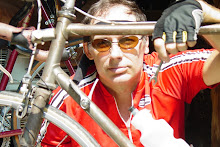We spent the last week of August in
Paris, just as tourists, celebrating life milestones. I quickly
noticed that cycling in Paris is nothing like cycling in American
cities. A case could be made for it being the premier large cycling
city in the Western Hemisphere. This is not an in-depth study,
though. Herewith a set of photos as tentative evidence:
Art bike:
A standard step-through city-use bike
that is nearly always plain black; but someone went to a lot of
trouble to give it a brilliant, unique Jackson Pollock-style paint
job. And it gets regular use, as I found it gone some days. Maybe
it was on loan to the Pompidou.
The Classic:
I include this shot of an ordinary
vintage bike just for sentimental reasons; I rode a nearly identical
bike for many years in the 80s and 90s, down to the chromed fork, top
bar cable clips and center-pull brakes, and I hated having to change.
(I did have a better seat post.) I forget what happened to it.
Probably stolen. Nice to see someone keeping this thing going
indefinitely.
Boulevard de Magenta Bike Lanes:
I was so amazed at seeing the Blvd. de
Magenta for the first time that I was almost run down by a
fast-moving young Parisian on a bike. You will note (if you are a
cyclist) that there is a long, straight, well-marked, unobstructed,
separate bike lane on each side of the boulevard which is protected
on both sides by trees. There is a buffer zone on both sides of the
lanes where the trees are planted. Cars stay on the roads, bikes
stay on the lanes, pedestrians stay on the wide sidewalks next to the
cafés. This was not installed last week; it has the solidity of
time behind it. There is the occasional bench in the buffer zone,
and bike racks on most blocks.
It's almost as if – dare I propose
something so outré – as if the French consider cycling to
be a normal adult activity on a par with any other, and cyclists to
be ordinary human beings rather than depraved thrill-seeking
children!
I'd dearly love to see a comparable
photograph of any street in any major U.S. city. Anyone?
Bikeshare in Paris:
Named Vélib', it is ubiquitous,
heavily used, and ridiculously cheap, considering that the first half
hour trip is free, and there's no limit on the number of trips per
day. A person could quickly become familiar with the locations of
the stations and work it to be completely free after paying the
yearly fee of 29 Euros. This would be a huge savings over any other
form of transportation besides walking. There are other rate
options, such as the one-week rental of 8 Euros, making sense for
able-bodied tourists. According to the Wiki, in 2011 the system
averaged almost 86,000 trips per day. The
bikes are grey, either bland and soulless or tastefully chic, your
choice, and I witnessed a wide variety of people using them, in all
kinds of attire, almost never with helmets. This system was
initiated in 2007. I would have thought that it would be closely
studied and imitated by every city worldwide when planning their own
bikeshare systems; but that would be painfully logical. To blazes
with you, Mr. Spock, you pointy-eared pedant! We'll go to hell our
own way, thanks.
The Bullitt
Clockwork:
A bakfiets with
disc brakes and a Fifties-style modern art cocktail lounge.
Delivery Trike:
Give a man a
brand-new, heavy-duty machine, maybe with one of those
electric-assist front wheels, and what's the first thing he does with
it? That's correct: he makes bets on how big a thing he can move
with it. In this case it appears that the limit has been reached.
Merde!
Derelict:
I saw rather few
abandoned bikes compared to the average American city; of those, most
had been heavily scavenged. So this stood out as an oddity: a
typical step-in town bike, sitting there long enough for the tires to
go flat and the pigeons to coat it with guano, and yet it is still
fully equipped. Alternatively, it might be an art installation. This
is Paris we're talking about. Art lurks everywhere, like young love,
ready to ambush you and play you for a fool.
The “Fastlife”
Fixie:
Elegant, sleek,
stylish, yet inexplicably crowned with a torn up ruin of a seat.
Minor disguise to discourage theft? Victim of sabotage? Something
to do with protesting the evils of globalization? Or a police search for contraband cigarettes electroniques?
The White Foldie:
Notice the
integral welded rack and the seat with the springs, which the owner
locks to the frame.
(in voce Poirot) Observe, mon ami, here we have the Most Peculiar Ménage à
Trois:
In close cahoots,
an inexpensive ordinary, a bakfiets with dwarvish coffin, and a
velocipede apparently custom built for a member of some other
species. Yeti? Wookie? Steve Buscemi? I regret I could not wait for
this trio to emerge from their café.
The Insouciant:
Raffish,
devil-may care, competent, and with a plywood platform (plate-forme
de contreplaqué) securely mounted
between the inverted bars. One imagines an impeccably Mohawked young
savage briskly striding out of the bookstore with a volume of Marxist
romantic poetry stuck in his jeans, clipping into his Looks and
warping out into traffic as if piloting an X-wing fighter.
The “Railway”:
Probably the most
typical privately-owned bike. Chain guard, mud guards, generator,
headlamp, rack, wire basket, bell, paint it black. Practicality gone
mad!
The “Gazelle”:
Poorly named, but
with many interesting features: the braking rod below the handlebars,
the integral rear-wheel lock, the full chain guard, the heavy duty
mudguard, the fancy rear light, the heavy-duty rack, and the frame
pump. Stolid, totally reliable, lasts forever. Maybe owned by a
German?
The “Sparta
Pickup”:
Alright, wipe that
smirk off your faces, wiseguys. This is the bike that that original
Marathon runner – Pheidippides, I think his name was – would have
died for if he hadn't died from running so hard. Note the super-duty
front rack, the extra-heavy-duty chromed seat springs, the doubled
top bar, the fully enclosed chain and the industrial-strength
bifurcated kickstand. If you're going for practicality, dammit, go
all the way. None of this plywood crap. Spartans – We brake for
nobody.
The “Kolkhoff”
- For Madmen Only
Okay,
let's take the mystique of the Practical Black Bicycle one
fucking step too far! Take your
time as you scan this magnificent machine. Your eye is irresistibly
drawn to the sex toy in the center, on which the cyclist sits and
pilots his Mystery Ship. A passenger sits in the back, his feet on
the bars (check your shoelaces!), wearing a little black bowler and
reading his newspaper; a charmante mademoiselle perches
elfinly (there is so such a word) on the seat welded to the front
bar, her feet on the bars bolted to the fork and her silk scarf
waving gaily in the breeze. It would be nice if she'd tear open her
blouse and start waving a huge tricolor, but let's not go nuts.
We're trying to get to work and deliver a gross of perfect croissants
in the big plastic crate in front before the expresso passes its
peak. And when we arrive, we will have a choice between the sturdy
bifurcated kickstand or the standard kickstand – unless the latter
is actually some kind of antenna that continually reports back to the
Central Scrutinizer somewhere deep under Paris.
Velotaxi at Work:
Velotaxis are
common wherever tourists might be found; they go fearlessly into
traffic. They come in such varied design that I don't think I saw
two alike. A fine thing I'm sure, but I wouldn't ride in one on a
bet.
Velotaxi waiting
for a fare:
I
have no explanation for this. Perhaps the guy just got this job last
week. Maybe he's filling in for his cousin. Maybe the round thing
behind him is a grill full of sausages. That would get my business.
But the colors! Sacre Bleu! (I
picked up lots of French in a week. It's an piss-easy language.) Unfortunately this was typical
of the place: filled with outstanding works of art, gorgeous women
dressed in impeccable taste, and all kinds of monuments of great
charm and dignity, and, with dismal regularity, things that are
exactly the opposite. Ugly graffiti, ridiculous clothing on people
other than tourists, establishments selling le cigarette
electronique under the moniker
Le Crapoteur. Truth.
Will supply proof in my essay in preparation entitled Paris Street
Scenes.
The Yellow
Delivery:
Another very
heavy-duty practical bike with impressive racks, but at least it's
not black. Two big locks. We did not meet any of the legendary
suave and debonair Parisian thieves, but I'm sure they still ply
their trade with alacrity and diligence.
The Little Local Velovia:
Bakfiets for sale! I didn't actually see any of these orange wheelbarrows in use anywhere. All the ones I saw looked both more functional and more elegant. But somebody must be buying them. Pilgrims from Portland?
To Sum Up:
Ah,
Paris. Elegant, oblivious women everywhere; small dogs lifting their
legs over the bizarre shoes of store-window mannequins. Interesting
bicycles on every block. And should you feel for some reason
deprived of the refreshing sight of beautiful naked breasts (les
beaux seins nus), simply raise
your eyes and scan the majestic buildings for statues, and soon
you'll find relief. Just don't stumble into a busy bike lane as you
are gawking thusly; it would be terribly gauche.
Typical Parisian university students cramming for exams.



















































